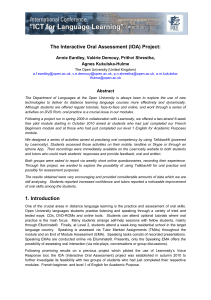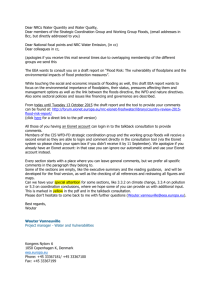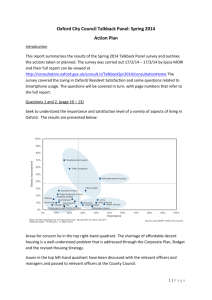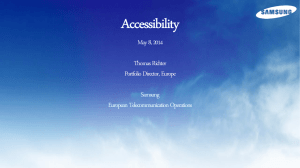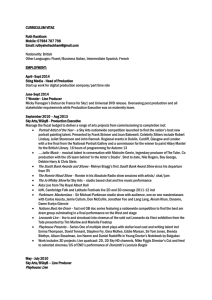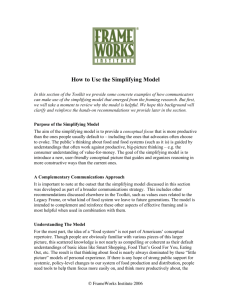Talkback radio: power and perception
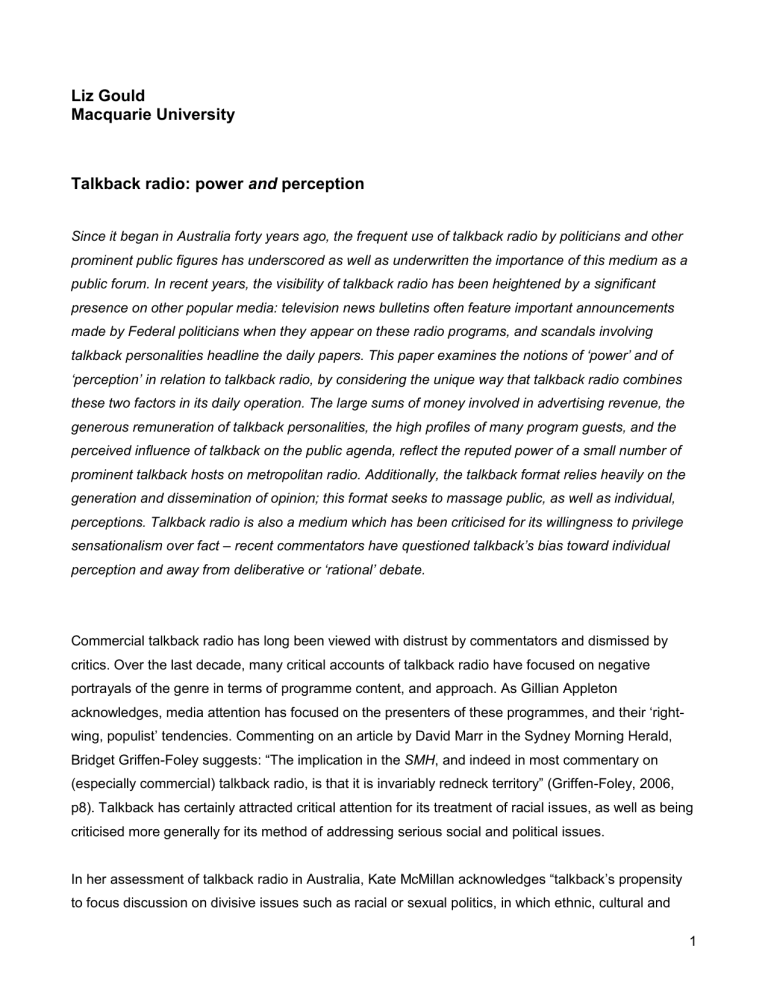
Liz Gould
Macquarie University
Talkback radio: power and perception
Since it began in Australia forty years ago, the frequent use of talkback radio by politicians and other prominent public figures has underscored as well as underwritten the importance of this medium as a public forum. In recent years, the visibility of talkback radio has been heightened by a significant presence on other popular media: television news bulletins often feature important announcements made by Federal politicians when they appear on these radio programs, and scandals involving talkback personalities headline the daily papers. This paper examines the notions of ‘power’ and of
‘perception’ in relation to talkback radio, by considering the unique way that talkback radio combines these two factors in its daily operation. The large sums of money involved in advertising revenue, the generous remuneration of talkback personalities, the high profiles of many program guests, and the perceived influence of talkback on the public agenda, reflect the reputed power of a small number of prominent talkback hosts on metropolitan radio. Additionally, the talkback format relies heavily on the generation and dissemination of opinion; this format seeks to massage public, as well as individual, perceptions. Talkback radio is also a medium which has been criticised for its willingness to privilege sensationalism over fact – recent commentators have questioned talkback’s bias toward individual perception and away from deliberative or ‘rational’ debate.
Commercial talkback radio has long been viewed with distrust by commentators and dismissed by critics. Over the last decade, many critical accounts of talkback radio have focused on negative portrayals of the genre in terms of programme content, and approach. As Gillian Appleton acknowledges, media attention has focused on the presenters of these programmes, and their ‘rightwing, populist’ tendencies. Commenting on an article by David Marr in the Sydney Morning Herald,
Bridget Griffen-Foley suggests : “The implication in the SMH , and indeed in most commentary on
(especially commercial) talkback radio, is that it is invariably redneck territory” (Griffen-Foley, 2006, p8). Talkback has certainly attracted critical attention for its treatment of racial issues, as well as being criticised more generally for its method of addressing serious social and political issues.
In her assessment of talkback radio in Australia, Kate McMillan acknowledges “talkback’s propensity to focus discussion on divisive issues such as racial or sexual politics, in which ethnic, cultural and
1
religious minorities are the focus of negative debate” (McMillan, 2005, p75). For example, Steve
Mickler’s analysis of the Sattler File, a controversial talkback program in Perth, details host Howard
Sattler’s persistent vilification of Aboriginal people (Mickler, 1997).
Based on a study of the media coverage of Pauline Hanson in 1996, Glen Lewis claimed “commercial talkback radio is a seeding ground for discriminations, ignorance, and prejudice in Australia, just as it has been in the US” (Lewis, 1997, p11). Almost a decade later, in an article entitled Creating Moral
Panic: Australian Outrage Radio , Robert O’Sullivan declares that “outrage radio and the Shock Jock phenomenon are part of the evolution of Australian radio” (O’Sullivan in Cryle & Hiller, 2005, p117).
Both Lewis and O’Sullivan expropriate a critique levelled at talkback radio’s American counterpart;
‘talk radio’ in the United States has often been characterised as sensational, brash and divisive and typified by ‘shock jocks’ such as Rush Limbaugh and Howard Stern.
In their oft-cited and derisive account of commercial talkback radio in Australia, Emperors of Air , Phillip
Adams and Lee Burton declare: “Talkback is the nadir of Australian media. It is characterised by sleaze and hypocrisy, by bombast and bigotry, by cynical populism and feigned rage.” (Adams &
Burton, 1997, pp25-26). And based on a content-analysis of talkback radio in New Zealand, Judy
McGregor similarly concluded that “the voice of this political talkback reverberates with low-level noise rather than resounds with serious or persuasive conversation” and that talkback radio programmes in that country exhibited ‘combustion rather than coherence’ (McGregor, 1996, pp32-3).
For many years critiques of talkback radio have maligned or dismissed talkback radio as ‘populist’, perfunctory or excessive. However, by focussing on the sensational aspects of the genre these critiques have often overlooked the agency of this form of communication. This paper seeks to provide context for some of the prevailing scholarly perceptions of talkback by considering the powerful commercial and political influences of this media format.
Commercial influence
Contemporary talkback radio has groomed a small number of professionals who hold considerable commercial clout; in addition to being paid large salaries many of the metropolitan radio talkback hosts also hold supplementary commercial contracts. Since the 1970s, John Laws has set the benchmark for active product endorsement, quickly becoming known in the industry as a master salesman (see
McGregor, 1979). He has most famously become a patron for Toyota automobiles and his contract with automotive products company Valvoline, begun in 1990, runs until his death (Hornery & Wyld,
2
2002) . Over his long career in radio, Laws has also penned poetry books, and inspired two
(authorised) autobiographies. He holds commercial agreements with a number of sizeable corporations: Qantas, Toyota, Valvoline, McGuigan Simeon Wines, Sony BMG Music, Biomedica,
Dymocks, Telstra, Key Sun Laboratories, and Insurance Australia Limited. His practice of offering advertisers a ‘live-read’ for an extra fee has become commonplace for many of the high profile metropoli tan hosts; these ‘personal endorsement’ contracts are generally offered only to those hosts with an established name and sufficiently large audience to attract advertisers). Neil Mitchell in
Melbourne is an exception; Mitchell refuses to do product endorsements not wanting to create a conflict of interest’ (Linnell, 1999, p28).
Recently retired late night talkback host, Stan Zemanek, is possibly the most entrepreneurial personality on Australian radio; his wideranging interests exceed Laws’ in number and range, though not in terms of wealth creation. Zemanek is the Chairman of Metro Media Corporation Pty Ltd (an umbrella organisation comprising Advertising consultancy, Financial Services, and Media
Communications). Zemanek also has an eponymous Home Loans business, and is chair of PR company The Publicity Machine . He performs at corporate speaking engagements and promotes and sells a Stan Zemanek merchandise range – mugs, keyrings and a cabaret album.
Over the years, many talkback hosts have also fostered a media presence outside of radio. Zemanek, following in the footsteps of radio greats such as Eric Baume, has a long-running involvement with the provocative women’s television chat-show Beauty & the Beast . Derryn Hinch and Alan Jones have both attempted heading television current affairs programs (although both returned to radio). John
Laws has hosted television series, and worked as a columnist for Sydney’s Sunday Telegraph . Neil
Mitchell writes for Melbourne’s Herald Sun . Others, particularly those in Sydney and Melbourne, have established careers across television and radio including Bert Newton, Ernie Sigley, Ross Stevenson,
Steve Liebmann, and Tim Webster.
Arguably the most powerful man in radio today, the agenda-driven king of Sydney talk-radio, Alan
Jones, presents daily commentaries on the Today show on Channel 9. This agreement has been held since 1995 between TCN Channel Nine and his production company ‘Belford Productions’. Jones is also the face of the 2GB book club, reviewing several books a month, and has released a CD entitled
Alan Jones Nostalgic Favourites (2GB, 2006). He also endorses DVD titles through EzyDVD online
(see EzyDVD, 2006). However, Jones’ business interests are far more extensive than his public declarations indicate, ve iled by the three ‘production’ companies he controls: Belford Productions,
Nadarci, and Hadiac. He also has equity interests in two Macquarie Network radio stations, his home radio station 2GB as well as Sydney station 2CH. Both Nadarci and Hadiac also have interests in
3
these stations (AMCA, 2006, p16). Widely reported at the time he also allegedly negotiated a 20% equity share in station 2GB’s profits after his defection from 2UE (ABA, 2003).
The commercial nature of talkback is a defining value underpinning the production of talkback radio programmes. Not only do advertisements make up a considerable portion of the on-air program, the station – as a business – relies on substantial advertising revenue. The Southern Cross broadcasting network, for example, which includes stations in Sydney, Melbourne, Brisbane and Adelaide, reports that flagship station 2UE generates advertising revenue of around $190 million and Melbourne station
3AW generates $122 million (Southern Cross Broadcasting, 2006). Talk radio uses more advertising than its musical counterparts and the higher salaries of its stars rely on higher profits from this advertising. The talk radio industry also markets itself to advertisers as a far more effective advertising medium than music radio, claiming greater attentiveness and engagement amongst talk radio listeners.
While the industry is generally candid about its reliance on commercial revenue, in 1999 the ABC’s
Media Watch programme revealed that in the case of a number of high profile industry figures, the receipt (and therefore the influence) of commercial funding was not transparent. The subsequent regulatory inquiry – into what was dubbed the Cash for Comment affair – revealed that a number of high profile talkback hosts were duplicitously accepting money to endorse products and companies without disclosing these agreements, compromising a position of public responsibility and violating broadcasting regulations (see Kirkpatrick, 2000). Investigating the business affairs number of high profile talkback hosts, including Laws, Alan Jones, Jeremy Cordeaux in Adelaide and Howard Sattler in Perth, the broadcasting regulator determined that a number of talkback radio hosts had been remiss in declaring all commercial interests, and that henceforth all radio announcers must openly declare all commercial affiliations. Adelaide broadcaster and station owner Jeremy Cordeaux, for example, was criticised during the regulatory enquiry on the basis of an initiative taken by his station for raising revenue. The ABC reported at the time that:
For $30 000 businesses could secure industry authority status on the Jeremy Cordeaux program, and whenever a comment on the client's area of business was required, Cordeaux would use someone from that organisation. The station's former news director Neil Vissy claims he was subjected to pressure from management to tailor news bulletins to meet the desires of clients. (ABC, 2000)
These revelations suggested that advertising revenue could exert significant pressures on programme content and programmers, in a manner that interfered with the listener’s ability to distinguish between information and product promotion. In addition to the lack of transparency in the material selected for
4
Cordeaux’s program, this form of commercial influence on the program agenda was also manifest as bias through omission. The Cash for Comment inquiry called into question whether the commercial underpinnings of the industry compromise the ability of these radio stations to provide forthright and unfettered public service.
…That’s entertainment?
Not only does the profit motive of commercial stations influence program content, it is perceived to have a negative influence on the shape of public discourse. Critiques of talkback echo the oft-cited debate about distinctions between the purpose and quality of the ‘old’ media and the ‘new’ media.
Broadly, the ‘old’ or ‘quality’ media, such as broadsheet newspapers, provide traditional coverage of seasoned analysis of current affairs and politics, whil e the ‘new’ media are often typified loosely as magazines and tabloid newspapers. Talkback radio is usually considered as an example of the ‘new’ media (see Lewis, for example, 1997).
McGregor & Browne suggest that the ‘new’ news media reverse the fact/opinion dichotomy of traditional news (in McGregor, 1996, p24). In the 1960s when talkback radio was first introduced, the concept of participatory talkback radio flouted the conventional (and restrictive) rules of access for public discourse on radio. For many years, Australian radio executives battled regulatory concerns about private citizens speaking on broadcast media, and about the quality of this discussion. The broadcasting regulator expressed concern about the ‘populist’ overtones of commercial radio, and fears of poor language usage. In contemporary talkback, questions of propriety, quality, and authority have largely been pushed aside. Rather than being based on the authority or expertise of the speaker, the motivation for participation in talkback programmes has been replaced by an emphasis on the
‘emotional’ authority of the speaker.
The importance of ‘opinion’ to the success of the talkback radio format was quickly recognised by broadcasters in the early days of the format, as talkback hosts sought to engage listeners as well as to encourage callers. Popular Melbourne broadcaster Ormsby Wilkins acknowledged the importance of combining commentary and opinion. Wilkins explained:
When I started off giving commentaries I had a great reputation for impartiality, but no audience. I soon changed that. I learned that if you are going to hold the attention of the man under the shower or the woman in the kitchen you have to be sharp and lively (Wilkins, 1975, p13).
5
As early talkback practitioners such as John Laws and John Pearce have recounted, when they were rude to callers, listener interest soared (see for example, Pearce, 2002). An established talkback formula has evolved where announcers are largely cast as disseminators of strongly held convictions.
As Judy McGregor suggests: “the content of political talkback relies on the credibility of the host and the audience emotion generated, rather than the persuasive and logical nature of the reasoning inherent in what is said” (1996, p29). Talkback practitioners seek to evoke affective – rather than rational – responses from audience members, and listeners are encouraged to analyse political and social issues in emotive terms.
While this emphasis has attracted criticism from many commentators (as we have seen), talkback hosts instead endorse the perception that talkback is merely ‘entertainment’.
John Laws’ famous comment – used as defence during the Cash for Comment trials – that he is an entertainer and not a journalist, has since been echoed by other talkback personalities. Jeremy Cordeaux, former 5DN presenter and talk-radio practitioner for over four decades, (recently) commented:
The buffoonery and the sort of redneck radio component has got some appeal to the general public - the same as a brawl d uring a football match, it's a bit of entertainment…But you can't call it influential, you can't call it seriously contributing to any debate or helping our decision-makers (in Ahwan, 2006).
Thus, one of the strategies for defence by the industry – as a response to allegations of undue commercial influence – has been to dismiss the agency of talkback. Yet this position is contrary: on the one hand, talkback asks to be considered only entertainment, on the other, many of these programmes purport to address serious social and political issues. Acknowledging the constraints on access for members of the public to traditional media, radio stations like talkback because it involves the listeners. Adams and Burton cynically claim that contemporary talkback hosts actively endorse the democratic potential of talkback: “[Talkback makes] claims …to the high ideal of demos. We are hearing, we are told, ‘the voice of the people’.” (Adams & Burton, 1997, pp25-26). Even Jeremy
Cordeaux who dismissed talkback as ‘a bit of entertainment’ frequently referred to his own longrunning program as the ‘court of public opinion’ (Gowing, 2006, p12), and declared that "[talkback] is the most powerful court in the land” (Ahwan, 2006).
Indeed, the defence of talkback radio as innocuou s or simply as ‘entertainment’ underplays the significance of this form of public debate. News, current affairs, and other public issues provide a large body of programming material for contemporary talkback programs, and most of the popular morning and ‘drive-time’ metropolitan talkback programmes strongly emphasise news and current affairs material; in turn, this material lends talkback an authority and power as a media form.
6
Politics, power and talkback radio
Since the early days of talkback, politicians have recognised the potential of the talkback to reach segments of the population. Many state premiers have established regular spots on talkback radio programs, taking advantage of the local appeal of radio. Gough Whitlam made use of talkback during the lead up to the Federal election campaign, Bob Hawke was known to make use of talkback radio programs and Paul Keating once famously declared ‘if you educate John Laws you educate middle
Australia’ (in Goot, OCAP). However it has been the incumbent Prime Minister’s embrace of the genre over the last decade, since winning office in 1996, that has seen talkback enjoy a newfound prominence on the public and media agenda. As has been widely acknowledged, no other prime minister before Howard has made such frequent and regular appearances on these programs – radio appears to be Howard’s political media genre of choice.
Since his election win in March 1996, Howard appears frequently with a small number of hosts on metropolitan radio stations: Neil Mitchell (breakfast) and Nick McCallum (drive) on station 3AW, and in
Sydney, Alan Jones on 2GB and John Laws on 2UE. Although he does appear on a mix of commercial and local ABC radio stations across the country, Howard’s radio appearances are concentrated in the Sy dney and Melbourne radio markets. Likewise, access to Howard’s Cabinet ministers is often restricted to a handful of non-journalists. As ABC talk radio host, Jon Faine, notes:
“the concentration of power in so few hands is worthy of closer examination” (Faine, 2005, p176).
Furthermore, the high level of political surveillance and media monitoring by large news organisations as well as major political parties ensure that other media also covers politician’s appearances on talkback. Not only are politician s aware that their performances are being ‘media monitored’, but as
Murray Goot notes: government leaders appearing on morning talkback can set the day’s media agenda, and program excerpts may frame news and comment in the print media the following day
(Goot, OCAP). Moreover, talkback has the ability to not only put issues on the agenda, but, as Turner has noted, to revive dying issues (Turner et. al., 2006, p115), or, to heighten public sentiment or awareness about particular issues. The increased political interest in talkback radio has seen the format take on a significant role as a creator and disseminator of public affairs in Australia.
7
Conclusion
In recent years, talkback has enjoyed a high profile. While the transgressions of individual talkback presenters have frequently made headlines, this negative press has also heightened the visibility of this medium. Scholarly interest and media attention in talkback has increased in the last five years in the wake of two headline-making scandals that neatly highlight some of the consequences of the commercial and political power underpinning (metropolitan) talkback radio programming. The first was the official inquiry concluded in 2000 by the broadcasting regulator, then the Australian Broadcasting
Authority, investigating allegations that several top-rating talkback hosts had not disclosed payments received for personal commercial affiliations: dubbed the ‘Cash for Comment’ affair. The second time the talkback radio industry hit the headlines was in 2004, whe n issues from the ‘Cash for Comment’ affair resurfaced after one talkback host (John Laws) publicly implicated another host’s involvement
(Alan Jones) in an intimate trio with the head of the broadcasting regulator, and the Prime Minister of
Australia. After enduring several weeks of gossip and controversy, the embattled head of the ABA took an early retirement while the Prime Minister continued to deny the allegations. The latter incident
– although short-lived – affirmed that not only does talkback radio carry commercial influence, but that it has considerable political leverage as well. However, despite increasing scholarly attention, the implications of the commercial and political power of talkback radio are not yet fully understood.
8
Bibliography
Adams, Phillip & Burton, Lee. (1997). Talkback: Emperors of Air . St. Leonards: Allen & Unwin.
Ahwan, Lauren. (2006). Cordeaux says he was made for talkback radio. Australian Associated Press . source: Factiva. 12 June.
Appleton, Gillian. (1999). The Lure of Laws: an analysis of the audience appeal of the John Laws program. Media International Australia incorporating Culture and Policy, 91, 83-95.
Australian Broadcasting Authority. (2003). ABA Finds No Breach In Relation to Control of 2GB and
2CH. Media Release NR 28/2003, 12 May. Retrieved from www.aba.gov.au/newspubs/news_releases/archive/2003/28nr03.shtml
.
Australian Broadcasting Corporation. (2000). Broadcaster Rejects Claims He Misled Listeners. AM ,
Radio National, 10 February. Retrieved 10/02/07 from http://www.abc.net.au/am/stories/s98657.htm
.
Australian Media & Communications Authority. (2006). Current Controllers . Retrieved from www.amca.gov.au/acmainterwr/_assets/main/lib100450/current_controllers.pdf
.
EzyDVD. (2006). Alan Jones Classic Collectibles. EzyDVD. Retrieved 12/12/06 from http://www.ezydvd.com.au/promo.zml?pid=517&ddat=1&dsal=1&dsav=1 .
Faine, Jon. (2005). Talkback Radio and Democracy. R. Manne, (ed.) Do Not Disturb: Is the Media
Failing Australia?
Melbourne: Black Inc. Agenda, 167-188.
Goot, Murray. Talkback. Oxford Companion to Australian Politics. Oxford University Press, forthcoming.
Gowing, Georgia. (2006). Cordeaux's voice of the people. Eastern Courier Messenger , 14 June, 12.
Griffen-Foley, Bridget. (2006). Redneck Radio?
Australian Book Review , February, 8.
Hornery, Andrew, & Wyld, Ben (eds.). (2002). Laws leads the dealers. Sydney Morning Herald, July 4.
Retrieved 08/12/06 from http://www.smh.com.au/articles/2002/07/04/1025667010953.html
.
Kirkpatrick, Rod. (2000). News media chronicle, July 1999 to June 2000. Australian Studies in
Journalism , 9,139-175.
Lewis, Glen. (1997). The Media and the Pauline Hanson Debate: Cheap talk or free speech?
Australian Journal of Communication, 24(1), 9-41.
Linnell, Garry. (1999). Difference of opinion - Victorian values. The Bulletin , 27 July, 28.
O’Sullivan, Robert. (2005). Creating Moral Panic: Australian outrage radio, in (eds.) Cryle, D. & Hillier,
J., Consent & Consensus: politics, media and governance in 20 th
Century Australia , Perth: Curtin
University of Technology.
McGregor, Craig. (1979). John Laws: The man you love or hate. National Times , 18-24 March, 9-14.
9
McGregor, Judy. (1996). The Rhetoric of Political Talkback Radio in New Zealand: Combustion or coherence? Australian Journal of Communication , 23(2), 24-33.
McMillan, Kate. (2005). Racial Discrimination and Political Bias on Talkback Radio in New Zealand:
Assessing the Evidence. Political Science , 57(2), 75-91.
Mickler, Steve. (1997). The “Robespierre” of the Air: Talkback Radio, Globalisation and Indigenous
Issues. Continuum , 11(3), 23-36.
Pearce, John. (2002). For the Love of Mike. Archived at National Library of Australia, Pandora electronic collection. Retrieved from http://members.mpx.com.au/~encore/index.html
.
Rowe, David. (1992). Just Warming ‘Em Up: radio talkback and its renditions. Continuum: the
Australian Journal of Media & Culture , 6(1), 14-26.
Southern Cross Broadcasting. (2006). Radio. Retrieved 16/2/07 from www.southerncrossbroadcasting.com.au
.
Turner, Graeme, Tomlinson, Elizabeth, & Pearce, Susan. (2006). Talkback Radio: some notes on format, politics & influence. Media International Australia incorporating Culture and Policy , 118, 107-
119.
Wilkins, Sally. (1975). The talkback king: Ormsby Wilkins: the saving grace of sanity on commercial radio. Age , 19 July, 13.
2GB. (2006). Alan Jones Recommends…. 2GB Bookclub. Retrieved 12/12/06 from http://www.2gbbookclub.com/ .
10
